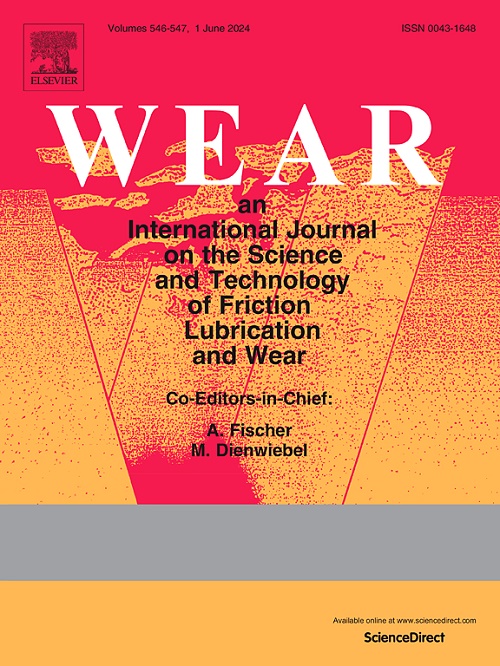Influence of heat treatment on the wear behavior of an Al-Cu-Mg-Sn MMC reinforced with TiB2
IF 5.3
1区 工程技术
Q1 ENGINEERING, MECHANICAL
引用次数: 0
Abstract
The need to reduce emissions has pushed the automotive industry toward the introduction of light-weight components, which has increased the interest in metal matrix composites (MMC) based on light alloys in applications where the strength-to-weight ratio, hardness and wear resistance are important. Age hardenable aluminum alloys reinforced with ceramic particles can meet these needs. This study analyses the influence of solution heat treatment and age hardening on the wear rate and friction coefficient of an Al-Cu-Mg-Sn alloy reinforced with TiB2 under sliding contact conditions against spheres of Si3N4 and AISI 52100 Steel. The experiments show that adhesion is the main wear mechanism, with abrasion as a significant secondary effect. The presence of TiB2 particles in combination with the ageing treatment contribute to the reduction of both friction coefficient and wear when compared with the same aluminum alloy without ceramic particles. The results are explained as a function of the hardness increase and the tribological compatibility between the alloy and contacting spheres. On a microstructural level, the severe plastic deformation associated to sliding wear is clearly observed. Dissolution of intermetallic particles is complete in the tribolayer and grain refinement is much stronger than what is observed in single-phase alloys.
热处理对TiB2增强Al-Cu-Mg-Sn MMC磨损性能的影响
减少排放的需求推动了汽车行业向轻量化部件的引入,这增加了人们对基于轻合金的金属基复合材料(MMC)的兴趣,在这些应用中,强度与重量比、硬度和耐磨性很重要。用陶瓷颗粒增强的时效硬化铝合金可以满足这些需求。研究了固溶热处理和时效硬化对TiB2增强Al-Cu-Mg-Sn合金与Si3N4和AISI 52100钢球在滑动接触条件下磨损率和摩擦系数的影响。实验表明,黏着磨损是主要的磨损机制,磨损是次要的。TiB2颗粒的存在与时效处理相结合,与不含陶瓷颗粒的相同铝合金相比,摩擦系数和磨损都有所降低。结果解释为硬度增加和合金与接触球之间的摩擦学相容性的函数。在微观结构水平上,可以清楚地观察到与滑动磨损相关的严重塑性变形。金属间颗粒在摩擦层中完全溶解,晶粒细化比在单相合金中观察到的要强得多。
本文章由计算机程序翻译,如有差异,请以英文原文为准。
求助全文
约1分钟内获得全文
求助全文
来源期刊

Wear
工程技术-材料科学:综合
CiteScore
8.80
自引率
8.00%
发文量
280
审稿时长
47 days
期刊介绍:
Wear journal is dedicated to the advancement of basic and applied knowledge concerning the nature of wear of materials. Broadly, topics of interest range from development of fundamental understanding of the mechanisms of wear to innovative solutions to practical engineering problems. Authors of experimental studies are expected to comment on the repeatability of the data, and whenever possible, conduct multiple measurements under similar testing conditions. Further, Wear embraces the highest standards of professional ethics, and the detection of matching content, either in written or graphical form, from other publications by the current authors or by others, may result in rejection.
 求助内容:
求助内容: 应助结果提醒方式:
应助结果提醒方式:


